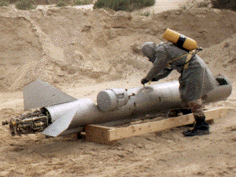Kh-28
| Kh-28 (NATO reporting name: AS-9 'Kyle') |
|
|---|---|

USAF EOD specialist disassembles presumed Kh-28 – Iraq 1991
|
|
| Type | air-launched anti-radiation missile |
| Place of origin | Soviet Union |
| Service history | |
| In service | 1973–current |
| Used by | FSU, Warsaw Pact, India, Iraq, Vietnam |
| Production history | |
| Designer | Alexander Yakovlevich Bereznyak |
| Manufacturer | MKB Raduga |
| Specifications | |
| Weight | 720 kg (1,590 lb) |
| Length | 597 cm (19 ft 7 in) |
| Diameter | 43 cm (16.9 in) |
| Warhead | Blast fragmentation |
| Warhead weight | 160 kg (353 lb) |
|
|
|
| Engine | Two-stage liquid-fuel rocket |
| Wingspan | 193 cm (6 ft 4.0 in) |
|
Operational
range |
110 km (59 nmi) |
| Speed | Mach 3.0 |
|
Guidance
system |
Inertial guidance with passive radar seeker |
|
Launch
platform |
Su-17M/Su-20/Su-22M, Su-24M, Tu-16, MiG-25BM, MiG-27, Tu-22M |
The Kh-28 (Russian: Х-28; Nisan-28; NATO:AS-9 'Kyle') was the first Soviet anti-radiation missile for tactical aircraft. It entered production in 1973 and is still carried on some Sukhoi Su-22s in developing countries but is no longer in Russian service. Use of the Kh-28 was restricted by its weight, limited seeker head, bulk and fuelling requirements, and it was superseded by the smaller, solid-fuel Kh-58 (AS-11 'Kilter') in the early 1980s.
Soviet offensive doctrine in the early 1960s assumed that widespread use of nuclear weapons would disable Western radar-based air defence systems through electromagnetic pulses (EMP) effects. Consequently, they paid little attention to the development of anti-radar missiles. However, in January 1963 the Berezniak design bureau (which became MKB Raduga in 1967) was tasked with developing such a missile as part of the K-28P weapon complex based around a 'Wild Weasel' version of the Yak-28 'Brewer' bomber (hence -28; the 'K' stands for kompleks, P stands for protivradiolokatsyonny 'anti-radar').
The main difficulty came in the design of the APR-28 guidance system undertaken by CKB-111 (later NPO Avtomatika). This meant that the Kh-28 missile was not ready until the 1970s. Flight trials were carried out on a Yak-28N, but by then the Yak-28 had ceased production and was perceived as obsolete, and the K-28P system was cancelled. Instead the Kh-28 was adapted for use by standard attack aircraft, in particular the Su-24 'Fencer-A' and Su-17M 'Fitter-C'.
The design of the Kh-28 was similar to – but smaller than – Raduga's Kh-22 (AS-4 'Kitchen') and KSR-5 (AS-6 'Kingfish') anti-shipping missiles. The Su-24 could carry one under each wing, and used the on-board Filin ('Eagle Owl') targeting system. The Su-17M could only carry one Kh-28 on the centreline, and used the Myetyel/Metel ('Blizzard') system in a pod under the right wing, later replaced by the Vyuga ('Snowstorm') pod.
...
Wikipedia
